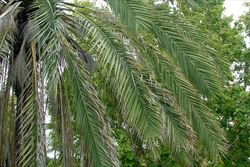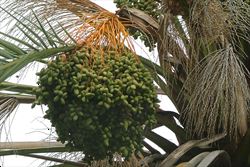Click on images to enlarge

habit (Photo: Forest and Kim Starr, USGS)

large leaves with numerous elongated leaflets (Photo: Sheldon Navie)

undersides of leaflets (Photo: Sheldon Navie)

large cluster of immature fruit and old flower clusters branches (Photo: Sheldon Navie)

close-up of immature fruit borne on orange branches (Photo: Sheldon Navie)

leaf bases and clusters of mature fruit (Photo: Sheldon Navie)

young plant (Photo: Forest and Kim Starr, USGS)
Scientific Name
Phoenix dactylifera L.
Family
Arecaceae (Queensland, New South Wales, the ACT, Victoria, Tasmania, Western Australia and the Northern Territory)Palmae (South Australia)
Common Names
date, date palm
Origin
This species probably originated in south-western Asia and the drier parts of northern Africa, but because of its widespread cultivation since ancient times its native distribution is obscure.
Naturalised Distribution
Naturalised in many parts of northern and central Australia, particularly in wetter habitats in arid regions. It is most common and widespread in the northern and western parts of Western Australia. Also naturalised in some parts of the Northern Territory and in the northern and eastern parts of South Australia. Sparingly naturalised in western Queensland and possibly naturalised in New South Wales.
Also naturalised in south-western USA (i.e. California and Arizona) and Hawaii.
Notes
Date palm (Phoenix dactylifera) is regarded as a significant environmental weed in Western Australia and as an environmental weed in the Northern Territory. It was recently listed as a priority environmental weed in two Natural Resource Management regions.

